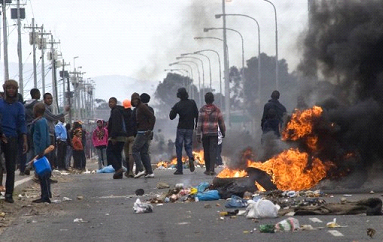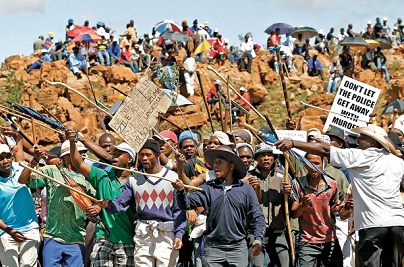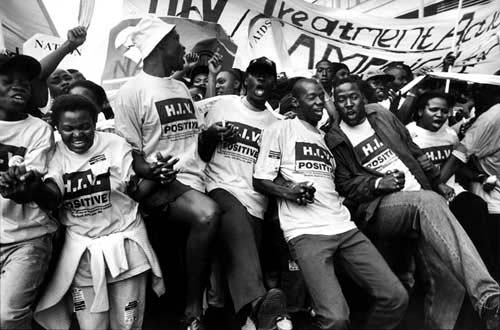Since South Africa’s advent to democracy in 1994, public protests either service delivery protest, protest against undemocratic laws or land distribution has become integral part of the society, particularly from 2004 as generally recognized when the country’s democracy was 10 years old. The second decade of democracy has been characterized by escalation of popular protests, increased militancy reminiscent of the anti-apartheid struggle days. Since the beginning of 2014 police revealed that Gauteng alone had experienced more than 500 protests, of which over 100 had turned violent. The escalation of these protests was also tracked by a research group, Municipal IQ, which showed a sharp increase in protest action since 2009. These protests are view as “service delivery”, “rebellion of the poor”, “municipal revolt” or “ring of fire”. Most of the recorded protest had taken place in the informal settlements or poor urban areas in the country’s biggest metro such as Cape Town, Johannesburg and Ekurhuleni. Although there is no consensus on how to classify those protest, it has been acknowledged that majority of the protests are about service delivery.
 People walk past burning barricades during a protest against deficiencies in government services in Gugulethu, an impoverished township near Cape Town, in August 2012. Source: AFP/Rodger Bosch
People walk past burning barricades during a protest against deficiencies in government services in Gugulethu, an impoverished township near Cape Town, in August 2012. Source: AFP/Rodger Bosch
Whereas the reasons for the protests either violence or non-violence vary most of the protests were attributed to the failure of service delivery. Poor service delivery of housing, electricity, water and sanitation topped the grievances in various communities. There are other protests relating to laws that are considered undemocratic such as Information Bill, and e-tolls in Johannesburg instituted by South Africa National Road Agency (SANRAL).
However, recent diagnosis by the South African Institute of Race Relations suggests that the deeper reason for most public protest is rooted in very high levels of youth unemployment and the dependency on the State. It further argues that the sluggish economic growth is not paralleled by job creation and many people are unable to be absorbed into private sectors while increasing dependency on the state. In this regard, better service delivery is viewed as not an answer but increasing private sector employment is seen a key to defusing popular anger against the state.
Community organization and movement such as the Right to Know Campaign, Treatment Action Campaign, rights group Section 27, Citizen for Marikana Campaign, Operation Khanyisa, Abahlali baseMjondolo, No Land! No House! No Vote!, and others has emerged out of those protests. For example, The Treatment Action Campaign (TAC) was at the forefront of the crusade to turn around the Mbeki government’s approach to HIV/Aids and secure antiretroviral treatment for those afflicted with the disease. Rights Group Section 27 successfully forced the government to deliver textbooks in Limpopo.
Specialized local government data and Intelligence service company Municipal IQ recently shows that South Africa had almost one protest every second day this year with Gauteng and the Eastern Cape were the most protest-ridden provinces. Furthermore, by January 2013 the data shows that service delivery protests in 2012 accounted for 30 percent of protests recorded since 2004. Between 2008 and 2013 approximately 3000 protest took place. Burning of Councilors homes and public infrastructures, poo throwing, road blockages and unlawful land occupation has been tactically used to voice the grievances.
 Mineworkers at Marikana, North Westh. Source: Siphiwe Sibeko/Reuters
Mineworkers at Marikana, North Westh. Source: Siphiwe Sibeko/Reuters
Some of the protest turned violent resulting in loss of lives, damage to property and looting. The death of protester Andries Tatane allegedly at the hands of eight police officers, during a service delivery protest in Ficksburg in the Free State on April 13, 2011 was the most widely publicised one. The industrial action by mineworkers at Amplats mine at Marikana in the North West resulted in 34 deaths in August 2012. Recently in October 2013 the protesters in Cape Town broke away from the crowd and started looting stalls and shops in St George's Mall, forcing shop owners and traders to pack away their goods for fear of being attacked by the mob.
Saba, A., and Van der Merwe, J., (2013). Revealed ”“ the true scale of SA service delivery protests [with original offical data], from the Media24, 22 January [online]. Available at www.m24i.co.za [Accessed 17 January 2014]|
Allan, K., and Heese, K., (2011). Understanding why service delivery protests take place and who is to blame. Available at www.municipaliq.co.za [Accessed 17 January 2014]|
Cronje, F., (2014). Behind the rise of protest action in South Africa. Available at www.politicsweb.co.za [Accessed 23 February 2014]|
Patel, K., (2013). Public protests: Gauteng’s rising pressure cooker, from the Daily Maverick, 16 May [online]. Available at www.dailymaverick.co.za [Accessed 17 January 2014]|
Isaacs, L., (2013). Cape Town braces for CBD protests, from iAfrica, 28 November [online]. Available at www.iafrica.com[Accessed 20 January 2014]


